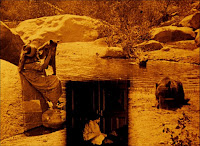“Mrs. Ivers has proved time and again that she yields
the palm to no mere man megaphone manipulator.” Betty Compson
I don’t know about you but, like a lot of the
compulsively inquisitive/acquisitive, I have a considerable archive of the un-read,
the un-listened to and the un-watched. Watching Mark Cousin’s excellent new
series, Women Make Film – a film school that just happens to be run by women
– I reach out to the Kino Lorber *six* disc box set, Pioneers: First Women
Filmmakers and select a film by a woman I’ve never heard of… this is a time
to broaden our minds.
IMDB has The Call of the Cumberlands being
directed by Frank Lloyd but it has now been identified as having been directed by Julia Crawford Ivers who, according to April Miller’s excellent
biography on the Women’s Film Pioneer website, is chiefly remembered for scripting
some twenty films for William Desmond Taylor (she was even one of those
implicated in his murder in 1922).
 |
| Julia Crawford Ivers |
Ivers clearly understood structure and Cumberlands fits a
lot of scenes into a relatively modest running time, she wrote the scenario
based on the novel by Charles Neville Buck, a Kentuckian who saw that changes
was coming and that the traditional blood rivalries would be swept away. To
Ivers credit, the source complexity doesn’t get in the way of the film’s range or
flow and she covers the ground well.
 |
| Dark deeds afoot... |
It begins in the mountainous woodlands of
Kentucky with the latest events of a family feud between the Souths and the Hollmans,
no relation to the Hatfield–McCoys or the Hamilton–Burrs. The families have
been in a truce for two years but dark deeds are afoot and Ivers shoots in near
darkness as a sniper takes aim at Jesse Purvy one of the senior members of the
Hollman clan. He’s badly wounded but asks his kin to kill Samson South to
avenge him if he dies.
There’s further impressive use of shadow as Ivers’
cameraman, Dal Clawson, catches the dappled shadow and bright light on young Sally
Spicer (Winifred Kingston), one of the South clan who is radiant innocence
watching the birds in the woodland. She comes across an abandoned oil painting
and finds its painter, George Lescott (Michael Hallvard) unconscious in the
shadows having slipped whilst engrossed in his view.
 |
| Dappled shadows as Sally looks for the missing painter. |
Sally takes Lescott back home to recuperate and whilst Samson’s father isn’t keen on allowing strangers to stay, he starts to bond with the painter over their love of art; trying to capture views that make the “eyes sing”. Meanwhile, the Hollmans are trailing the attempted assassin with bloodhounds and there’s some gorgeous night-shots of men with torches heading inexorably to the South’s land.
 |
| Richard L'Estrange, Dustin Farnum and Winifred Kingston |
 |
| Samson has a good look in the life class... |
Here’s the nub of things, in New York, distant from the
Cumberlands in time as much as space, Samson develops aesthetically and forms a
bond with Lescott’s sister Adrienne (Myrtle Stedman) who decides to teach him the
manners of polite society. But is Manhattan society polite? Not so much that
they all tolerate Samson and there’s feuds here of a different more political
and capitalist nature. Will Samson be drawn into these dirty deeds and will he
forget about his Sally who, even as he is playing tennis with Adrienne, is teaching
herself to read and write. None of the characters stop moving and that family feud
isn’t going to stop either; will Samson go all soft when it comes to defending
his family?
 |
| Sally confronts Tamarack |
"Ye lies, Tam'rack," she said, in a very low
and steady voice-a voice that could not be mistaken, a voice relentlessly
resolute and purposeful. "Ye lies like ye always lies. Yore heart's black
an' dirty. Ye're a murderer an' a coward. Samson's a-comin' back ter me.... I'm
a-goin' ter be Samson's wife." From Charles Neville Buck’s
original novel.
Ivers makes light work of Neville Buck’s overwrought prose - though many title cards reflect that local dialect - and adapts with a subtle dynamism. The story grabs
the attention even now despite being plagued by some chemical deterioration in some of
the middle sections – as you can see most of the film looks sharp! It’s a genre
film made with confidence and confidence to take a few risks with images and
storyline.
 |
| I love this shot through the window of Samson greeting Adrienne in a car... |
I like Ivers treatment of Sally and she places her in a
number of inventive shots that emphasise her connection to nature and
commitment to her Samson; she's a key part of his loyalties and the highest of
stakes when he's being lured by East Coast aesthetics, society and Adrienne.
The painter's sister is herself a free spirit but one operating within the
learned behaviours of classical music, etiquette and even the sport of kings.
Ivers pre-figures Nell Shipman with Sally's imagined comparison of a similar
life versus woodland frolics with friendly bears and she also lifts a shot or
two from Lois Webber's Shoes as Sally looks into a mirror realising that she
can't change who she is.
  |
| Influenced by Lois Webber and influencing Nell Shipman? |
There is also a new Kino Lorber disc, The Intrigue:
The Films of Julia Crawford Ivers which has four films including A Son
of Erin (1916) which she directed after Cumberlands. It’s available from Kino Lorber direct and it's on my birthday list!
Bonus screen shots!!























No comments:
Post a Comment